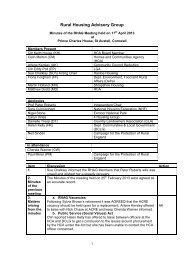Rapid Evidence Assessment of the Research ... - Rural Housing
Rapid Evidence Assessment of the Research ... - Rural Housing
Rapid Evidence Assessment of the Research ... - Rural Housing
Create successful ePaper yourself
Turn your PDF publications into a flip-book with our unique Google optimized e-Paper software.
<strong>Rapid</strong> <strong>Evidence</strong> <strong>Assessment</strong> <strong>of</strong> <strong>the</strong> <strong>Research</strong> Literature on <strong>the</strong> Purchase and Use <strong>of</strong> Second Homes<br />
121. Halifax (2007), in its annual survey <strong>of</strong> rural housing, focuses on 132 rural local authorities in Britain. It<br />
usefully compares <strong>the</strong> proportions <strong>of</strong> second homes and social housing. South Hams has more second homes<br />
than social housing. Five o<strong>the</strong>r local authorities have at least half <strong>the</strong> number <strong>of</strong> second homes compared to<br />
social housing – Eden, North Cornwall, North Norfolk, Penwith and South Lakeland.<br />
Sub-local authority distribution <strong>of</strong> second homes<br />
122. There is limited and patchy evidence at sub-local authority level on <strong>the</strong> prevalence <strong>of</strong> second homes.<br />
Direct Line (2005, p6) identifies Salcombe in South Devon and Windermere in <strong>the</strong> Lake District, with 75 per<br />
cent and 16 per cent respectively <strong>of</strong> properties as second homes as rural second homes ‘hotspots’. Ma<strong>the</strong>w<br />
Taylor MP (Hansard, 2006) has suggested that second home ownership in some Cornish parishes is as high as<br />
80 per cent. A study in Suffolk (Suffolk County Council, 2004) shows that whilst about two per cent <strong>of</strong> <strong>the</strong> total<br />
housing stock in <strong>the</strong> county was second homes, according to 2004 Council Tax data, ownership is<br />
concentrated in particular villages, with <strong>the</strong> housing stock in certain parishes consisting <strong>of</strong> 25 per cent or more<br />
second homes.<br />
Characteristics <strong>of</strong> places with large concentrations <strong>of</strong> second homes<br />
123. The Commission for <strong>Rural</strong> Communities (2006, p11) shows that <strong>of</strong> <strong>the</strong> 113 (out <strong>of</strong> 354) local authorities in<br />
England with over one per cent <strong>of</strong> <strong>the</strong> housing stock identified as second homes in 2004/5, 58 were rural. This<br />
suggests that over half <strong>of</strong> authorities with more than one per cent second homes were urban authorities. The<br />
large proportions <strong>of</strong> second homes in some London Boroughs have already been indicated above. Using<br />
survey evidence from estate agents (Gilbert, 2001; p17) suggested that “One trend is for an increasing number<br />
<strong>of</strong> people to buy <strong>the</strong>ir main family property fur<strong>the</strong>r out <strong>of</strong> London, and have a flat/pied-à-terre in London, which<br />
<strong>the</strong>y may use three to four days a week. Part <strong>of</strong> <strong>the</strong> reason for this is that property prices within daily<br />
commuting distance have been steadily increasing.”<br />
124. For those working in London but having a second home away from <strong>the</strong> capital Gilbert (2001, p18)<br />
suggests that “Being within a two-hour commute to London is still a defining radius for many London second<br />
homebuyers, particularly where <strong>the</strong>re is easy access to a good road/motorway or rail link. This is particularly<br />
true for people with weekend cottages.” Wallace et al (2005, pp44-46) suggest that while studies from <strong>the</strong><br />
1970s stressed <strong>the</strong> importance <strong>of</strong> isolated rural locations for second homes, <strong>the</strong> importance <strong>of</strong> accessibility to<br />
a main home in an urban location has become more important.<br />
Gallent<br />
125. et al (2005, pp21-23) point out that in rural areas economic decline has been one <strong>of</strong> <strong>the</strong><br />
underlying causes <strong>of</strong> second homes growth and that ‘surplus’ rural dwellings were an initial source <strong>of</strong> supply<br />
for second homes. As this surplus has diminished second homes purchasers have generated concerns about<br />
<strong>the</strong>ir competition in <strong>the</strong> housing market with local residents. Gallent et al (2005, p26) quote earlier work<br />
(Coppock, 1977) that suggest that <strong>the</strong> spatial distribution <strong>of</strong> second homes is “Controlled by a number <strong>of</strong><br />
factors including <strong>the</strong> distance from major centres <strong>of</strong> population, <strong>the</strong> quality and character <strong>of</strong> <strong>the</strong> landscape in<br />
importing regions, and <strong>the</strong> presence <strong>of</strong> specific features such as <strong>the</strong> sea, rivers, lakes and mountains.” Gallent<br />
et al (2005, p28) also note <strong>the</strong> role <strong>of</strong> motorways in making attractive rural areas more accessible for second<br />
home owners and, more broadly, <strong>the</strong>y argue that second homes locations cannot be viewed in isolation from<br />
<strong>the</strong> areas from which <strong>the</strong>y import demand: “Second home regions are not geographically isolated and <strong>the</strong><br />
expansion <strong>of</strong> second home ownership is dependent on <strong>the</strong> importing region’s social, economic and physical<br />
relationship with neighbouring ‘feed’ or exporting regions.” It is argued that “The central issue with English<br />
second homes is not <strong>the</strong>ir overall number – proportion or relative to <strong>the</strong> national housing stock – but <strong>the</strong>ir<br />
tendency to concentrate in <strong>the</strong> most attractive areas and to combine with retirement purchasing to create a<br />
range <strong>of</strong> highly localised difficulties” (Gallent et al, 2005; p30).<br />
38






